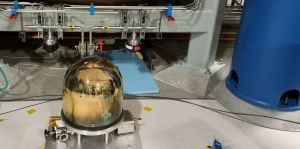Difference between revisions of "Environmental Noise"
(Created page with "https://journals.aps.org/prd/abstract/10.1103/PhysRevD.97.102007 Measurement and global correlation of Schumann resonances (2018)") |
|||
| Line 1: | Line 1: | ||
| + | = Newtonian noise = | ||
| + | Terrestrial gravity fluctuations due to environmental fields and moving or vibrating objects poses an important source of environmental noise in gravitational-wave (GW) detectors. This noise is known as Newtonian noise (NN) or gravity-gradient noise. Unless associated with objects, NN has a steeply falling spectrum, which makes it relevant especially at low frequencies. | ||
| + | |||
| + | Current research activities are on the modeling of NN, by analytic studies as well as numerical simulations, and on the development of noise-mitigation methods especially coherent noise cancellation. | ||
| + | |||
| + | [[https://link.springer.com/article/10.1007/s41114-019-0022-2 Terrestrial Gravity Fluctuations (2019)]] | ||
| + | |||
| + | == Seismic == | ||
| + | [[File:HeaderNNsmall.jpg|Compact beam-rotation sensor at LIGO Hanford|thumb]] | ||
| + | |||
| + | [[https://agupubs.onlinelibrary.wiley.com/doi/abs/10.1029/2018JB016608 Correlation studies of oceanic microseisms with an 3D array at the former Homestake mine (2019)]] | ||
| + | |||
| + | === Body-wave NN cancellation === | ||
| + | In underground detectors we can suppress Newtonian Noise (NN) from surface waves very well, but we have still to deal with NN from body waves. | ||
| + | |||
| + | We need then to understand if we can actually suppress this kind of noise. The basic idea is to cancel it out from the data by using a Wiener filter. This comprises the placement of some seismic sensors which should record the seismic field in order to reconstruct the NN affecting the test mass. Instead of placing real seismometers we modeled a simple isotropic and homogeneous seismic field which surrounds the test mass of the detector and that is composed only by body waves. With this model we found that with already 13 seismic sensors set in an optimal configuration we can reduce the NN by a factor 10, while we can still reach a factor 3 of reduction even with a degraded sensor configuration. | ||
| + | |||
| + | [[https://iopscience.iop.org/article/10.1088/1361-6382/ab28c1 Body-wave NN cancellation for ET (2019)]] | ||
| + | |||
| + | === Advanced Virgo + === | ||
| + | [[https://iopscience.iop.org/article/10.1088/1361-6382/ab5c43/meta Array analysis at Virgo (2019)]] | ||
| + | |||
| + | [[https://iopscience.iop.org/article/10.1088/1361-6382/ab81cb Virgo NN reduction by recess at Virgo (2020)]] | ||
| + | |||
| + | === LIGO === | ||
| + | [[https://journals.aps.org/prl/abstract/10.1103/PhysRevLett.121.221104 Array analyses at LIGO Hanford (2018)]] | ||
| + | |||
| + | == Atmospheric == | ||
| + | |||
| + | === Advanced Virgo + === | ||
| + | [[https://link.springer.com/article/10.1007%2Fs00024-020-02428-w Empirical mode decomposition for acoustic-transient analysis (2019)]] | ||
| + | |||
| + | = Magnetic noise = | ||
[[https://journals.aps.org/prd/abstract/10.1103/PhysRevD.97.102007 Measurement and global correlation of Schumann resonances (2018)]] | [[https://journals.aps.org/prd/abstract/10.1103/PhysRevD.97.102007 Measurement and global correlation of Schumann resonances (2018)]] | ||
Revision as of 11:58, 5 April 2020
Contents
Newtonian noise
Terrestrial gravity fluctuations due to environmental fields and moving or vibrating objects poses an important source of environmental noise in gravitational-wave (GW) detectors. This noise is known as Newtonian noise (NN) or gravity-gradient noise. Unless associated with objects, NN has a steeply falling spectrum, which makes it relevant especially at low frequencies.
Current research activities are on the modeling of NN, by analytic studies as well as numerical simulations, and on the development of noise-mitigation methods especially coherent noise cancellation.
[Terrestrial Gravity Fluctuations (2019)]
Seismic
[Correlation studies of oceanic microseisms with an 3D array at the former Homestake mine (2019)]
Body-wave NN cancellation
In underground detectors we can suppress Newtonian Noise (NN) from surface waves very well, but we have still to deal with NN from body waves.
We need then to understand if we can actually suppress this kind of noise. The basic idea is to cancel it out from the data by using a Wiener filter. This comprises the placement of some seismic sensors which should record the seismic field in order to reconstruct the NN affecting the test mass. Instead of placing real seismometers we modeled a simple isotropic and homogeneous seismic field which surrounds the test mass of the detector and that is composed only by body waves. With this model we found that with already 13 seismic sensors set in an optimal configuration we can reduce the NN by a factor 10, while we can still reach a factor 3 of reduction even with a degraded sensor configuration.
[Body-wave NN cancellation for ET (2019)]
Advanced Virgo +
[Array analysis at Virgo (2019)]
[Virgo NN reduction by recess at Virgo (2020)]
LIGO
[Array analyses at LIGO Hanford (2018)]
Atmospheric
Advanced Virgo +
[Empirical mode decomposition for acoustic-transient analysis (2019)]
Magnetic noise
[Measurement and global correlation of Schumann resonances (2018)]
